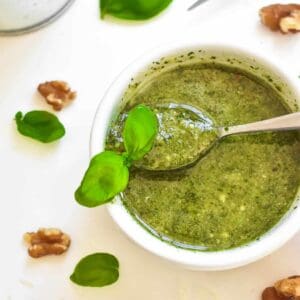Easy Homemade Basil Pesto Recipe
This homemade pesto recipe is easy to make in a food processor in less than 10 minutes! It's a great way to use up a bounty of fresh basil – goes well on pasta, veggies, chicken, pizza, sandwiches and more!
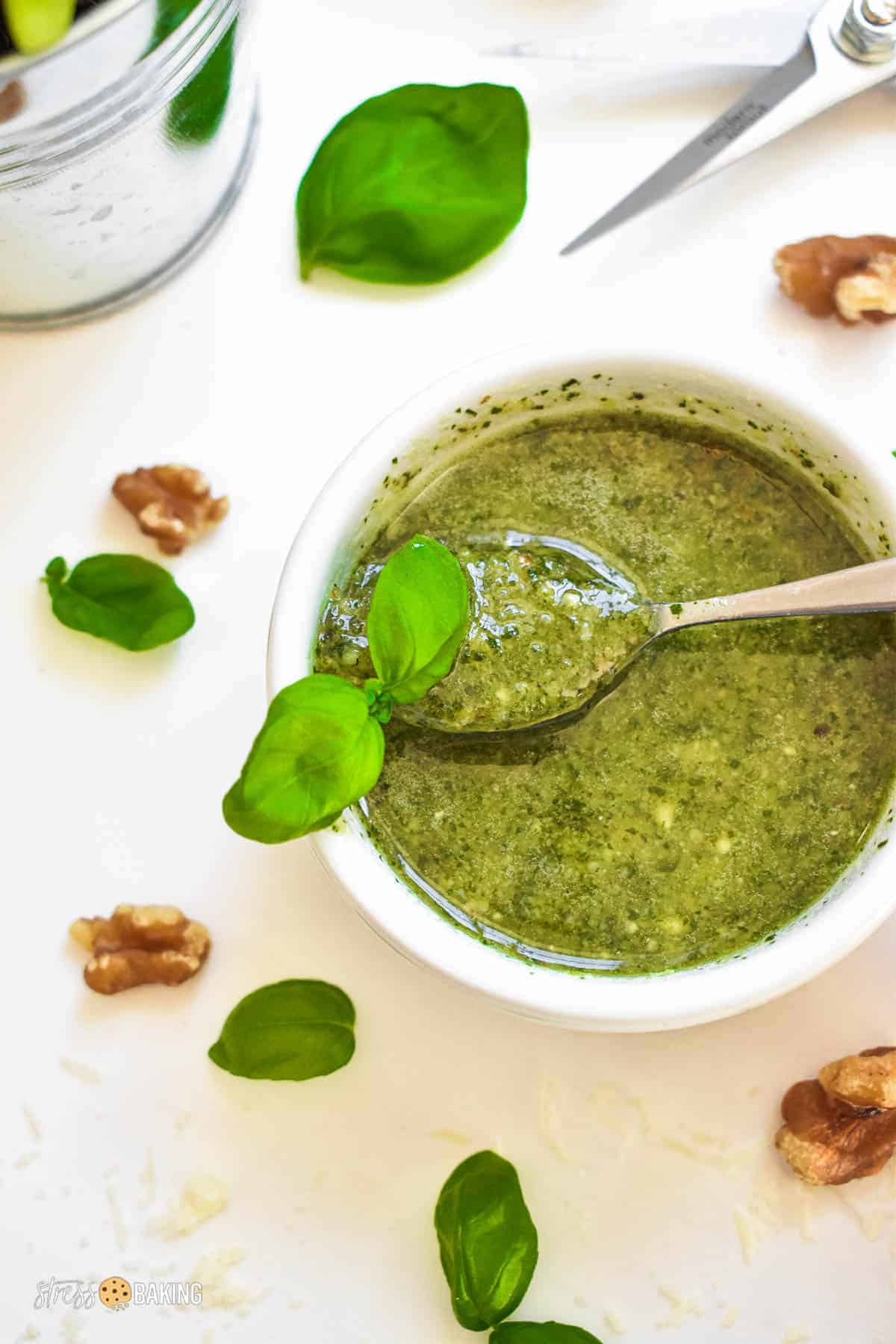
Growing basil is surprisingly easy and happens relatively quickly – which means that it's also easy to end up with an overabundance of basil!
My favorite way to use up a batch of basil is to make homemade basil pesto.
But before we dive into the recipe, let's go over the best way to prune basil leaves to ensure that you're allowing for new stem and leaf growth for a never-ending supply of aromatic fresh basil.
How to prune basil plants
Each time you cut back a basil plant stem, two new stems will grow and branch out from where you cut.
This means that consistent pruning is important to keep your basil plant healthy and producing new leaves.
And that means… more pesto for Future Us!
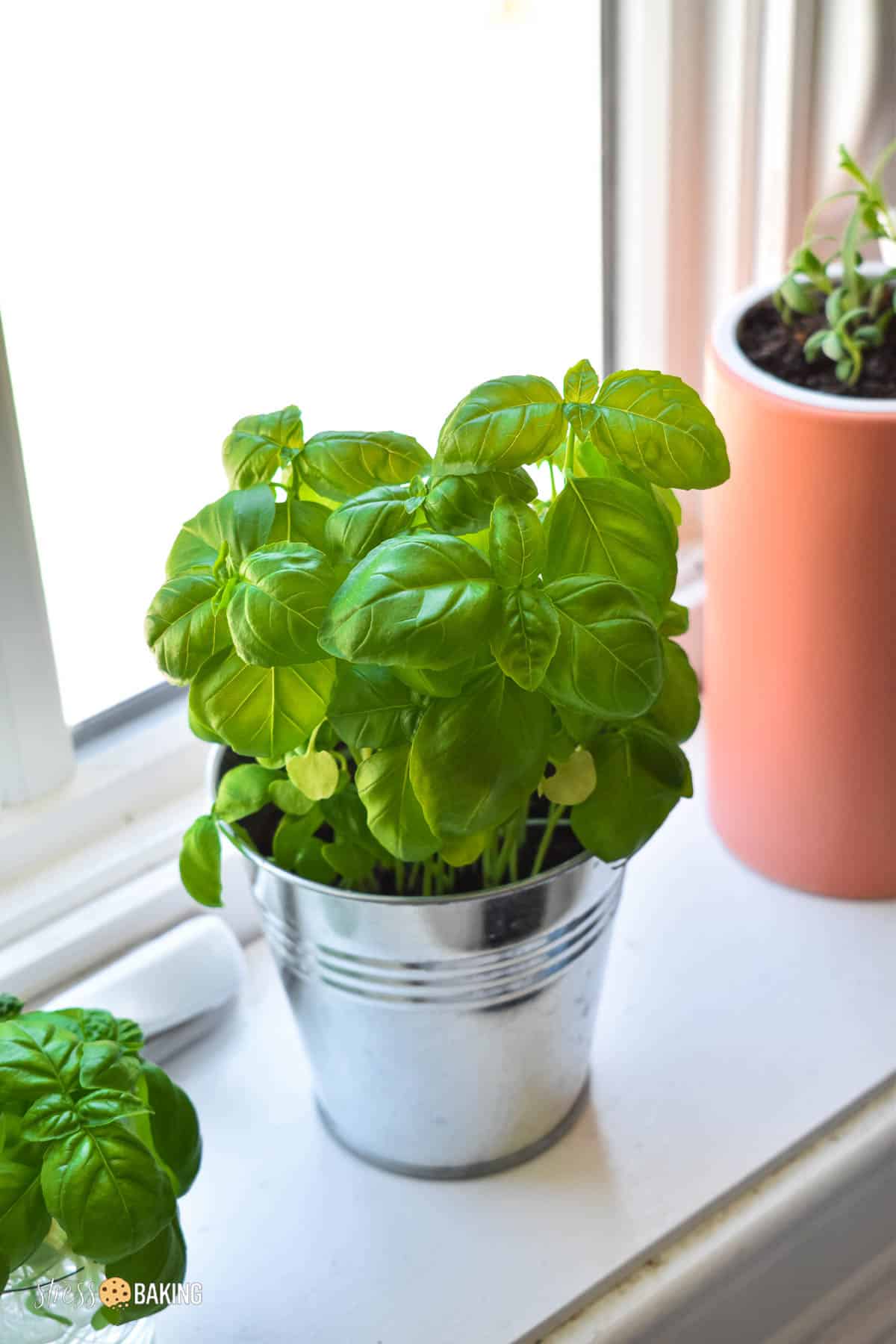
Once the basil stem is 6-8″ tall and has at least three sets of leaves, you'll want to start pruning.

Pinch the stem and use herb snips or scissors to cut about 1/4″ above the set of next set of leaves.
In my photo above, you'll see me cutting between the top two sets of large leaves – I simply couldn't get a good picture of me cutting closer to the bottom in the midst of all the leaves. I let it grow for a bit too long and it turned into a jungle!
Continue to water and prune your basil plant in the future, keeping in mind that the more individual stems you prune, the bigger your plant will grow and the more leaves you'll have to harvest.

What is pesto?
Pesto is a bright green, salty sauce that originated in Italy. A classic basil pesto recipe is typically made with:
- basil leaves
- garlic
- pine nuts
- Parmesan cheese or pecorino romano
- olive oil
- salt and pepper
The traditional way of making pesto is by crushing the ingredients together with a mortar and pestle (pestle, pesto – coincidence? I think not!), but for the sake of saving time, I like to make mine in a food processor.
Key Ingredients for Basil Pesto

- Nuts: You can use pine nuts, walnuts, pistachios, almonds, or sunflower seeds.
- Garlic: I peel and roughly slice up a couple of fresh garlic cloves, but you can also just peel the clove and toss it in whole!
- Basil: A lightly packed cup of fresh basil leaves is the star of the show. Fresh herbs are key.
- Salt and black pepper: Because you need to ensure it's seasoned, of course :)
- Extra-virgin olive oil: Use a good quality EVOO – the flavor is going to be prominent, so make sure it's something you enjoy the taste of.
- Parmigiano Reggiano: Freshly grated or shredded is always your best choice – pre-grated or pre-shredded doesn't have as much flavor, and is more dry.
- Lemon juice: It's completely optional, but depending on how I'm planning to use the pesto I might add a squeeze of fresh lemon juice as well.
What kind of nuts can I use in pesto?
Traditional pesto is made with pine nuts, but we use walnuts due to a pine nut allergy in our house.
You can swap the walnuts with a 1:1 substitute of:
- pine nuts
- pistachios
- almonds
- sunflower seeds


How to make homemade pesto sauce
It's easy to whip up in the bowl of a food processor, so you'll have a batch of pesto in 5-10 minutes. Once you have delicious homemade pesto you're probably never going back to store-bought pesto!
Note: Don't use a blender! It won't work the same way, and the results will have an odd texture.

Step 1: In a food processor, combine nuts and garlic.

Step 2: Pulse to combine until coarsely chopped.

Step 3: Add basil leaves, salt, and pepper.

Step 4: Process on low to medium speed until combined into a paste-like texture (about 1 minute).

Step 5: With the processor running on low to medium speed, add olive oil in a slow and steady stream until combined.
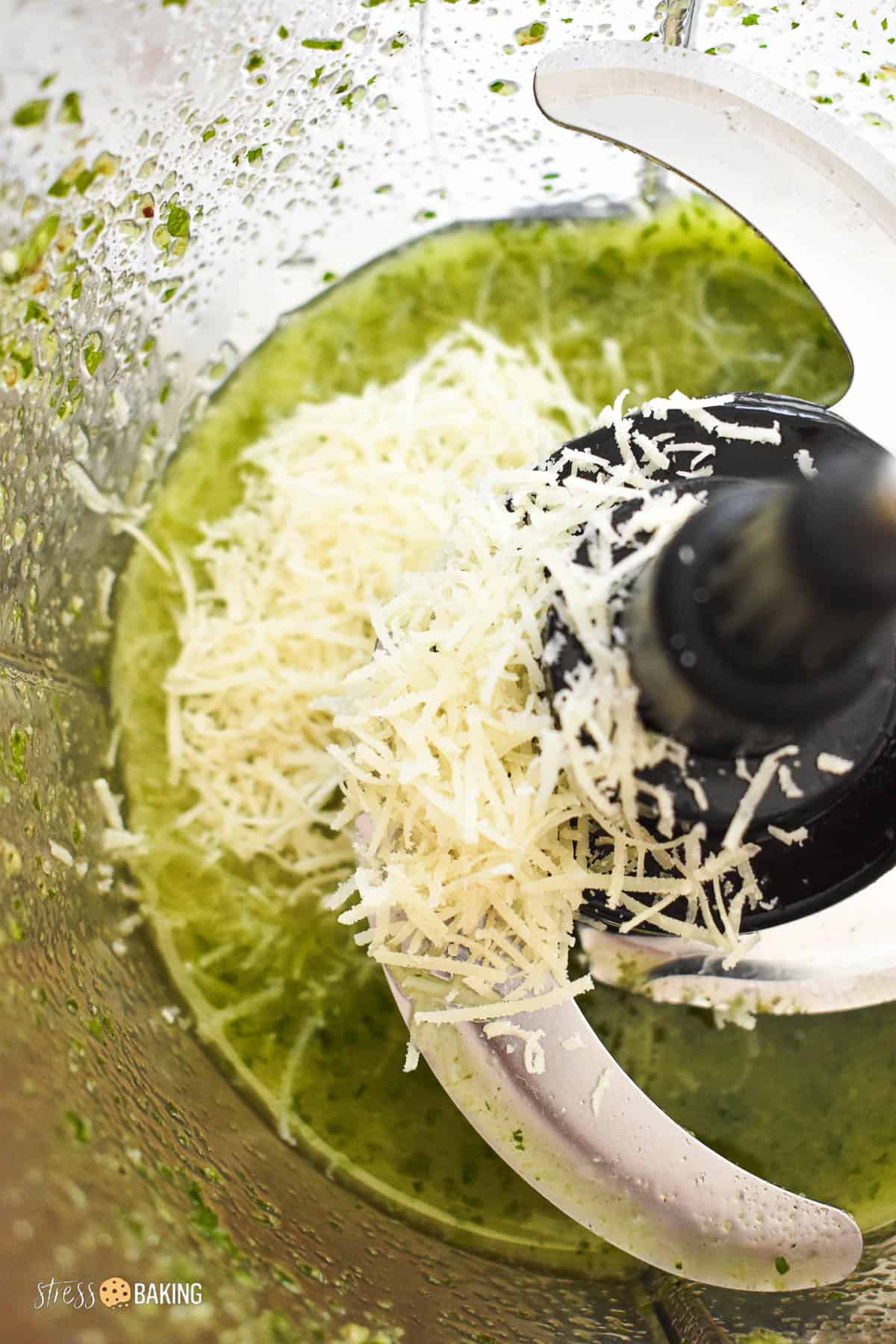
Step 6: Add grated cheese and pulse again to combine, 30-60 seconds.
Storing pesto
Store your freshly made pesto in an airtight container in the refrigerator for up to 1 week.
If you've made a particularly thick pesto sauce, try adding a thin layer of oil to the top of the pesto to help keep it moist.
Freezing pesto
Thankfully, leftover pesto freezes well! So if you want to make a big batch when using up your crop of basil, you can set Future You up for delicious pesto whenever you need it.
Store your pesto in small jars, freezer bags, or freezer-safe containers for up to 6 months.
You can also freeze portions in ice cube trays, and then after they've frozen solid you can store them in freezer-safe plastic bags.
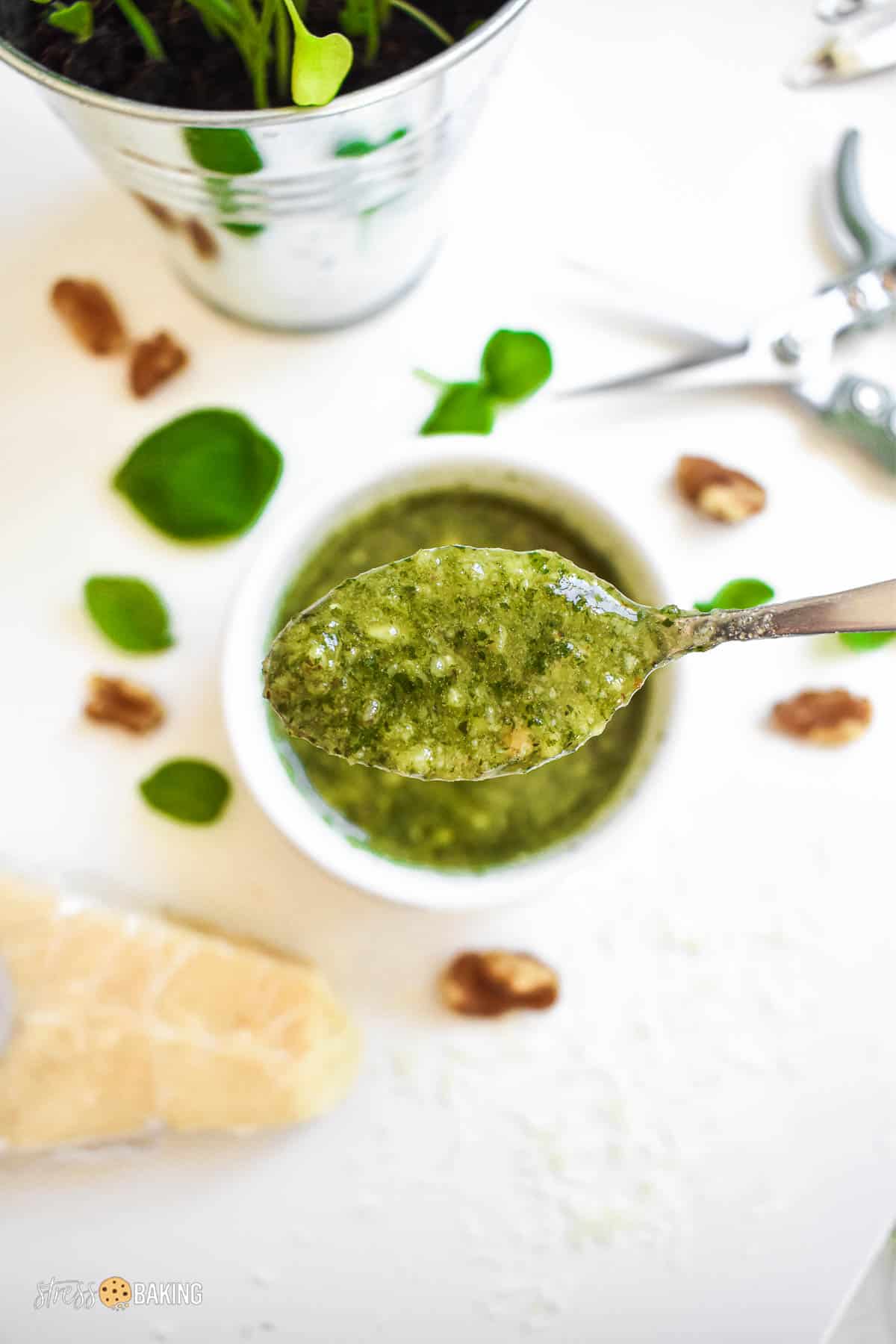
Can I use dried basil for pesto?
I don't recommend it. Using dried basil results in a dull, brownish pesto that isn't as aromatic and flavorful as using fresh basil.
I also find it to have a slightly bitter taste, and that's not what I'm going for.
What can I use pesto in?
The uses for fresh pesto sauce are frankly, endless! It's such a versatile sauce – pesto goes well on:
- Pasta (hot dishes and cold pasta salad)
- Grilled or roasted vegetables
- Chicken breasts
- Pizza
- Sandwiches
- Salads as an herby salad dressing – add a bit more extra virgin olive oil so that it drizzles easier
Leaving a comment and star rating is a great (and free) way to support Stress Baking. After you've enjoyed this recipe, click on the stars below and leave a comment to share your experience – thank you!
Easy Homemade Basil Pesto Recipe
Equipment
Ingredients
- 3 tablespoons walnuts
- 2 cloves garlic, chopped or whole cloves
- 1 cup fresh basil leaves, lightly packed
- ¼ teaspoon salt
- ⅛ teaspoon ground black pepper
- ⅓ cup extra virgin olive oil
- ⅓ cup grated Parmigiano Reggiano, or freshly shredded
Instructions
- In a food processor, combine walnuts and garlic and pulse to combine until coarsely chopped.3 tablespoons walnuts2 cloves garlic
- Add basil, salt, and pepper and process on low to medium speed until combined into a paste-like texture (about 1 minute).1 cup (24 g) fresh basil leaves1/4 teaspoon (¼ teaspoon) salt1/8 teaspoon (⅛ teaspoon) ground black pepper
- With the processor running on low to medium speed, add olive oil in a slow stream until combined.1/3 cup (72 g) extra virgin olive oil
- Add grated cheese and pulse again to combine, 30-60 seconds.1/3 cup (33 ⅓ g) grated Parmigiano Reggiano
- Store in an airtight container in the fridge for up to a week. Enjoy!
Video
Notes
Nutrition Facts
Nutrition Disclaimer
The provided nutrition information is generated by an automatic API and does not take variations across specific brands into account. This information is provided as a general guideline and should not be treated as official calculations. Learn more here.



